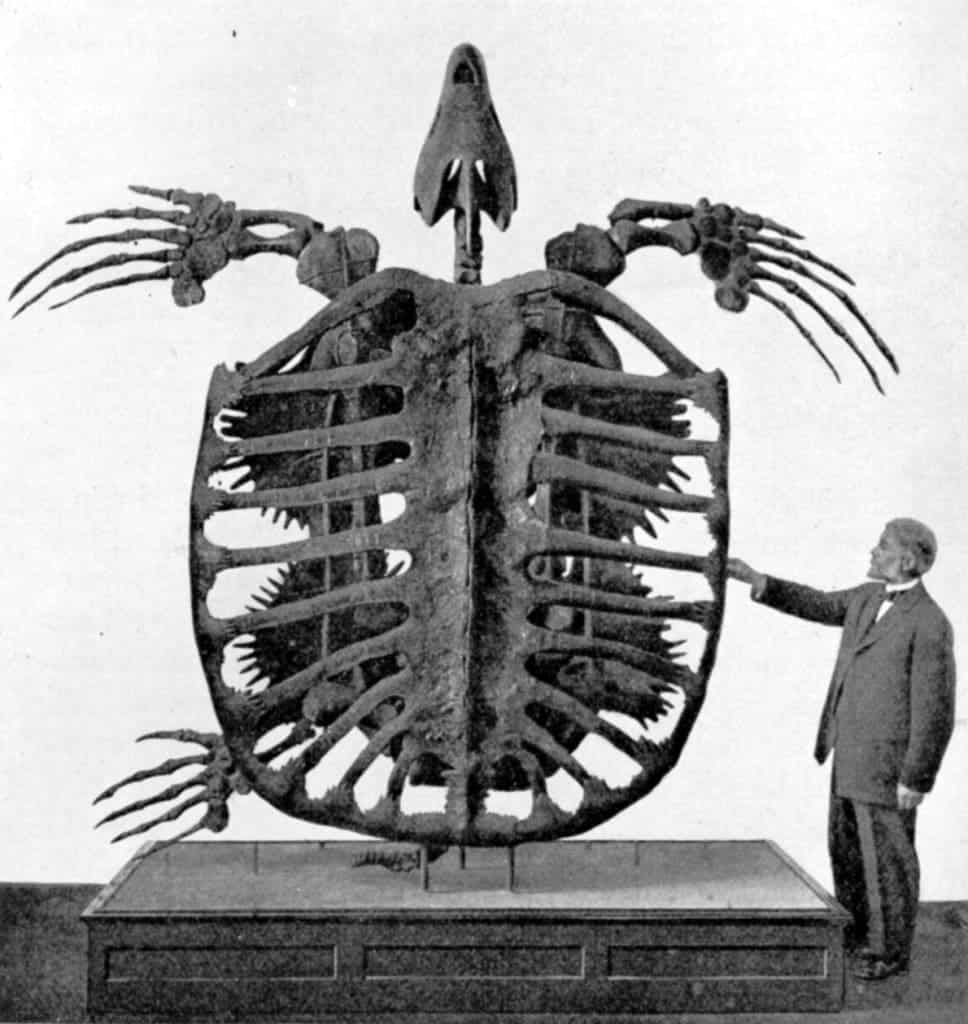When we think of turtles, we often picture small, hard-shelled creatures plodding along beaches or gliding through serene ocean waters. Yet, 70 million years ago, a truly colossal turtle, Archelon, dominated the seas.
This magnificent creature, now long extinct, was the largest turtle ever known. It measured 4.6 m (15 ft) from head to tail, surpassing any living turtle species by far.

The first Archelon fossil was unearthed in 1895 in South Dakota. This discovery marked a significant moment in paleontology, shedding light on a previously unknown giant of the Cretaceous seas. Subsequent findings have provided a more comprehensive understanding of this extraordinary turtle.
Archelon lived during the late Cretaceous period, a time when dinosaurs like Tyrannosaurus rex roamed the land and giant marine reptiles ruled the oceans. It was the era of big, scary dinosaurs, and Archelon was no slacker. Among some of the most famous titans of prehistory, Archelon held its own unique place.
The giant turtle lived in a sea we now call the Western Interior Seaway — a large inland sea that split North America into two landmasses for 34 million years. Because it was an inland sea, it was shallow. It was also filled with diverse marine life, ranging from plesiosaurs and mosasaurs to bony fish as well as invertebrates like ammonites and belemnites. Birds (these flying dinosaurs) were also abundant in the area and probably played a key role in the ecosystem.

In its prime, Archelon must have been a formidable presence in the Cretaceous oceans. Its size alone would have deterred many potential predators, although it likely faced threats from massive marine reptiles such as mosasaurs. Despite these dangers, Archelon thrived in a dynamic and often perilous ecosystem.
Unlike today’s leatherback turtles, however, Archelon wasn’t well adapted to the open ocean. It had weaker arms and was a less powerful swimmer — it preferred the shallower, calmer waters of the Western Interior Seaway. It would have been able to swim the open waters, but not for very long distances.
The turtle likely hunted and was a fierce predator itself.
The turtle’s beak-like mouth was another remarkable feature. Equipped with strong, scissor-like jaws, Archelon could feed on a variety of marine organisms, including mollusks, crustaceans, and possibly even jellyfish. Its diet likely played a crucial role in its ability to sustain its enormous size.

A giant turtle goes extinct
Archelon’s reign likely ended around 74 million years ago, a few million years before the mass extinction event that wiped out the dinosaurs. The exact cause of its extinction remains unclear.
The giant turtle may have been a victim of global tectonics — the slow movement of continents in geological time. Although it’s not clear why it went extinct, paleontologists speculate that it could have been connected to the change of the sea in which it lived. As the seaway progressively moved southwards, Archelon may have not been able to keep up with it. It became harder and harder to take care of its eggs and became more vulnerable to predators as its habitat changed.
However, changing water temperatures may have also played a role in the demise of the turtle.
The importance of studying ancient giants
Studying ancient giants like Archelon is important for several reasons. Firstly, it helps us understand the evolutionary history of reptiles and their adaptations over millions of years. By examining the physical characteristics and ecological roles of extinct species, scientists can trace the development of modern reptiles and their ancestors.
Secondly, fossils like those of Archelon provide evidence of past environmental conditions. The study of these fossils can reveal information about ancient climates, sea levels, and ecosystems, contributing to our understanding of how Earth’s environment has changed over time.
Finally, learning about prehistoric creatures like Archelon inspires a sense of wonder and curiosity about the natural world. These ancient giants remind us of the vastness of Earth’s history and the incredible diversity of life that has existed on our planet.
There’s a lot we don’t know about past (and present) life on Earth. But science is helping us understand it more and more with each passing day.



